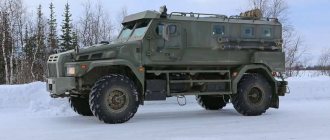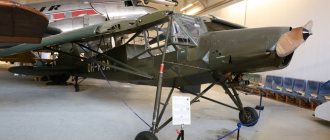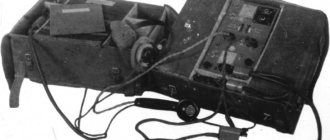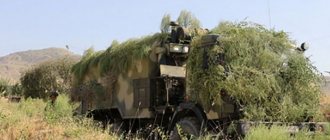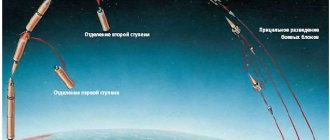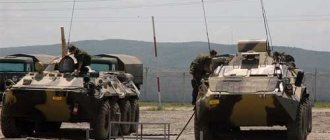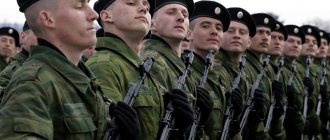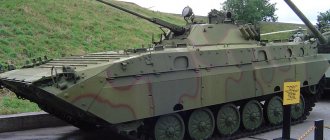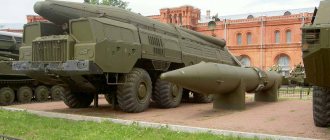Communication vehicle MS-1 (15B82) of the Pioneer UTTH complex in body 2212 on a MAZ-543A chassis
Its total weight with warhead and crew was 43.7 tons. On the highway, the self-propelled gun developed a speed of 60 km/h and had a range of 650 km. From November 1992 to the end of May 1993, state tests of a coastal battery of two Bereg complexes were carried out in Crimea, after which they were unilaterally included in the Ukrainian naval forces. After resolving mutual claims in 1996, the Bereg complex was put into service with the Russian Navy and entered combat duty in August 2003.
Self-propelled 130-mm gun A222-S1 of the Bereg anti-ship artillery complex. 1987
Communication, detection and control machines
A wide range of various autonomous radio engineering and command vehicles for highly specialized purposes was created in the USSR since the early 1960s with a focus on ensuring the most covert and effective combat use of promising mobile strategic missile systems. All these mobile vehicles were mounted on MAZ-543A and 543M chassis, equipped with standard habitable bodies with special equipment, autonomous power units, antenna devices, combat security equipment and life support systems. When on duty in sparsely populated regions, mobile power plants or an industrial power grid served as energy sources, and mobile canteens and dormitories were used for rest and food for the combat crew.
Communication vehicle MS-1 (15B82) of the Pioneer UTTH complex in body 2212 on a MAZ-543A chassis
Universal-purpose equipment includes communication vehicles of various configurations from the Krasnodar Instrument Plant (KPZ), which bore the generic names MS-1 and MS-2 and were designed primarily for use as part of mobile command posts of various strategic missile forces. Communication machine No. 1 or MS-1 was used to organize tropospheric radio communications with higher levels of control. Initially, its short- and ultra-short-wave lamp equipment was located in the equipment room of a medium-sized glazed body 2212 on chassis 543A, in the second compartment there was a combat duty room with racks and boxes for weapons, in the third there were two autonomous diesel generators ADA-12 with a power of 12 kW each. The body was equipped with heaters, a filter-ventilation unit or air conditioning, and several telescopic and whip antennas were installed on the roof. For the first time in the 15B57 version, the MS-1 vehicle was used in the command posts of the Temp-2S, Pioneer and Pioneer-K SRK. Then, in the 15B82 version, it was part of the Pioneer UTTH SRK, and in the divisions of the Topol complexes it served in the 15B179 version with modernized electronic-based equipment. As part of the mobile reserve command post 15B119 of the “Vybor” missile division, it was under the index 15B133.
Communications machine No. 2 or MS-2, better known as the heavy radio relay station R-406HF "Torf-2" of the highest command level, was developed in 1960 by order of the Strategic Missile Forces and put into service in 1963. Together with other means, it was part of the mobile command posts of the Strategic Missile Forces system and served to organize radio relay communications with the General Staff, army and front headquarters, to organize communications and control in units of missile systems on the move, in deployment areas and to monitor the performance of all elements of the complexes . The first samples of MS-2 were mounted on the 543A chassis, but from the mid-1970s the MAZ-543M became its basis. Their equipment room with an ultra-short wave complex of transceiver devices 15E1061 "Keychain" and the duty crew room were located in two compartments of a short sealed control cabin, which was the front part of a standard van body 6702. On the open rear section of the vehicle frame there was a folding antenna-mast device with a set of two tropospheric communication dish antennas. As part of the Strategic Missile Forces, for the first time, under the designation 15B75, the MS-2 vehicle was included in the regimental mobile command post “Barrier” of the Temp-2S and “Pioneer” combat missile systems; the 15B175 variant was part of the “Topol” complex. In the mobile reserve command post 15B119 of the Vybor missile division, it was designated 15B134.
Voentelecom presented the unique Tiger-US communications vehicle at the Army-2017 forum
Voentelecom CEO Alexander Davydov answers questions from a Zvezda TV channel correspondent about the company’s new products presented at the forum.
– What does Voentelecom do and what is within the company’s area of competence?
– Voentelecom traditionally deals with sensitive segments of the Russian economy. In the interests of the Russian Armed Forces, we deal with issues of information security and telecom infrastructure. Our specialists do this based on domestic trusted solutions - this is what distinguishes us from most players in the market.
– What is the innovation of the equipment produced by Voentelecom?
– Unlike many Russian and foreign players, we do not try to repeat what was done in the world before us, but try to be ahead of the curve, anticipating the technological trends that await us in the future.
Accordingly, our concept and what we present here today is, to a large extent, a leap forward for our armed forces. This is the first import-independent platform that we offer to our army; this is a Russian-developed hardware platform on which any communication system or automated control system for the armed forces can be built today. It can be used both in fixed echelons of the communication system and in field components.
From the point of view of building a communication system in a fixed echelon, we have already come a long way. We not only developed and produced our technical equipment, but also integrated them into the state defense order system, so we have very concrete successes here. Our technical means have competitive advantages; they are at the world level and in some places even surpass foreign analogues.
– One of your new products is a hardware communication platform based on the Tiger armored vehicle. Tell us more about him.
– “Tiger-US” is, in fact, a portation of those fixed-line fixed-line solutions that we have been able to install over the past two years into the field component. This is a technology that allows us to transfer all the services that we are traditionally accustomed to receiving from the Internet to the field communication system. Until now, this has not yet happened in our country. Today we received a mobile communications center combined with a command and staff vehicle. That is, we can provide our aircraft with a unified platform for providing all communication services and performing absolutely all combat missions.
We also present a line of domestic telecommunications equipment on which you can build any communication networks of any complexity, not only in specialized segments and systems sensitive from the point of view of information security, but also in civil systems.
This applies to our main operators, corporate networks, where we traditionally give our market to foreign vendors (suppliers). Today we are ready to offer alternative solutions based on the results of domestic science and domestic industry.
– What is the company striving for?
– We strive to become a noticeable player in the market, not only from the point of view of the company, not only in terms of the brand, but also from the point of view of solving government problems. Because whoever has telecommunication technology has peace and competitive advantage. Therefore, the minimum task is to become a full-fledged player in the market, the maximum task is to solve government problems in sensitive sectors of the economy.
We are now working on artificial intelligence systems, because everything created in terms of infrastructure needs reliable, efficient and secure management. We are actively looking in this direction, building automated systems and systems based on artificial intelligence.
Oleg Savitsky, First Deputy General Director of Voentelecom JSC, speaks about the unique capabilities of the special communication machine “Tiger-US”:
– What latest developments are you working on?
– Voentelecom is currently engaged in comprehensively equipping the fixed network of the Ministry of Defense of the Russian Federation with new communication equipment. We have made significant progress in this matter and have completely switched from imported (Chinese and American) equipment to domestic equipment.
It is worth noting that the first stage of this work was to equip the Crimean Peninsula with Russian equipment. Within two months, we ensured the connection of Crimea through the use of broadband access stations to the Russian mainland, bypassing Ukraine. And for the past year and a half, we have provided communications to all military units and units stationed in Crimea.
We have now actually made a revolutionary leap towards a software-defined architecture for network technologies. In addition, we are working on a system for transferring data from ordinary to senior managers. Today, such end-to-end information transfer is carried out in various ways. We developed the concept and within two months developed the hardware room, which is presented on the basis of the Tiger armored vehicle. Such hardware is capable of processing information and connecting to a fixed network in motion up to 150 Mbit, using broadband access to the communication station, as well as C- and Ku-band satellite communications.
In the parking lot, we provide communications, including connection to the core network through the use of a broadband access station. With the help of a repeater, communication is provided at a distance of up to 150 km. The total information flow is up to 150 Mbit/s. The platform can be transformed to use mobile cells, telephone exchanges for more than 1000 subscribers. It can also be used as a data storage system – mini-data center. This machine is not tied to any control unit. It's like a laptop that was handed to the commander of a rifle battalion or division commander. Depending on the combat missions, one or another application is downloaded, which ensures their implementation. In other words, it provides telephone communication, video conferencing, data and e-mail transmission, including the transmission of information that constitutes a state secret.
It can provide closed-circuit conference calls from anywhere in the country with the National Defense Command Center.
Evgeniy Zhilkov, Development Director of Voentelecom JSC, answers questions about the balance of production of civilian and military equipment.
– What solutions used in the military sector does the company produce for the civilian sector?
– Since we are the main supplier of equipment to the Ministry of Defense of the Russian Federation, during this time we have formed a certain cooperation in industry, from where we took our best samples and offer them to the military department with certain modifications in terms of information security. Having this experience and those solutions that fit well into the infrastructure of the Ministry of Defense, we offered them on the commercial market to companies in the transport and banking sectors. It turned out that these solutions are in great demand in these sectors of the economy.
For the civilian market, we make broadband access, provide wireless communications and cover the need for routing and switching. These are the most painful moments that we have in industry in Russia.
We also carry out work under contracts of the Ministry of Defense on equipment life cycles. We have separate contracts for the development, implementation, configuration, commissioning, commissioning, use and even disposal of equipment. We have experience using equipment throughout its entire life cycle. By offering such solutions, we significantly save the customer costs. Over five years, savings on equipment operation can be up to three to four times.

